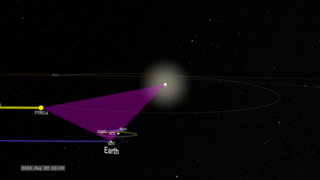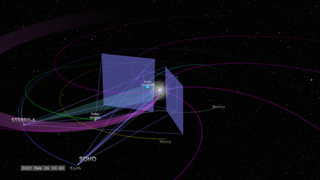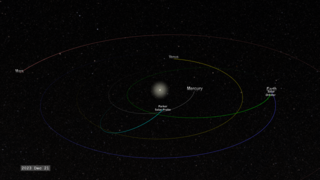Sun
ID: 4805
Using Solar Orbiter, Parker Solar Probe, and other sun-observing missions, in coordinated observations, we can learn far more about the solar atmosphere which surrounds and impacts Earth and other missions in space, crewed and uncrewed.
In these visualizations, we show the orbits of the inner planets, along with orbits of multiple solar missions: STEREO-A, Parker Solar Probe, Solar Orbiter, and SOHO at the Earth-Sun L1 Lagrange point.
The Parker spiral created by the solar magnetic field is represented by the magenta spiral lines emanating out from and rotating with the Sun.
During encounters, spacecraft conducting in situ measurements are highlighted.
Spacecraft doing imaging have a semi-transparent conical or rectangular frustum representing the field of view of the camera.
In addition to direct 'line-of-sight' conjunctions, the spacecraft can have 'magnetic' conjunction's where they are both crossing the same outward magnetic field line in the solar wind. This configuration is represented by a wide magenta band, spiraling along lines similar to the solar magnetic field lines. The bands are represented as broad since the precise timing of these alignments may depend on local conditions such as the solar wind speed. In these configurations, it is hoped to compare charged particle flows along the solar magnetic field lines.
In many encounters, the imaging is performed while another spacecraft is passing through the camera field of view conducting in situ measurements. Those images will provide a global view of the region through which the spacecraft is traversing, providing additional context for interpreting the in situdata.
To facilitate identification of these encounters in the visualizations, a tabular list is presented below. The table identifies which instruments may conduct imaging while others are doing in situ measurements.
Coordinated Heliosphere - How Solar Missions Work Together
The Parker spiral created by the solar magnetic field is represented by the magenta spiral lines emanating out from and rotating with the Sun.
During encounters, spacecraft conducting in situ measurements are highlighted.
Spacecraft doing imaging have a semi-transparent conical or rectangular frustum representing the field of view of the camera.
In addition to direct 'line-of-sight' conjunctions, the spacecraft can have 'magnetic' conjunction's where they are both crossing the same outward magnetic field line in the solar wind. This configuration is represented by a wide magenta band, spiraling along lines similar to the solar magnetic field lines. The bands are represented as broad since the precise timing of these alignments may depend on local conditions such as the solar wind speed. In these configurations, it is hoped to compare charged particle flows along the solar magnetic field lines.
In many encounters, the imaging is performed while another spacecraft is passing through the camera field of view conducting in situ measurements. Those images will provide a global view of the region through which the spacecraft is traversing, providing additional context for interpreting the in situdata.
To facilitate identification of these encounters in the visualizations, a tabular list is presented below. The table identifies which instruments may conduct imaging while others are doing in situ measurements.
| Encounter Window (yyyy-mm-dd) | Imagers | in situ Instruments |
|---|---|---|
| 2020-09-11 to 2020-09-29 | STEREO-A, Solar Orbiter | Parker |
| 2021-01-14 to 2021-01-18 | STEREO-A, SOHO, Solar Orbiter | Parker |
| 2021-04-24 to 2021-05-01 | STEREO-A, SOHO, Solar Orbiter | Parker |
| 2021-08-07 to 2021-08-20 | STEREO-A, SOHO, Solar Orbiter | Parker |
| 2021-09-18 to 2021-09-18 | Parker, Solar Orbiter, STEREO-A | |
| 2021-11-19 to 2021-11-23 | STEREO-A, SOHO, Solar Orbiter | Parker |
| 2022-02-23 to 2022-02-27 | STEREO-A, SOHO, Solar Orbiter | Parker |
| 2022-04-05 to 2022-04-05 | Parker, Solar Orbiter | |
| 2022-05-29 to 2022-06-05 | STEREO-A, SOHO, Solar Orbiter | Parker |
| 2022-09-04 to 2022-09-07 | Solar Orbiter | Parker |
| 2022-10-20 to 2022-10-20 | Parker, Solar Orbiter | |
| 2022-12-09 to 2022-12-12 | Solar Orbiter | Parker |
| 2023-03-16 to 2023-03-20 | Solar Orbiter | Parker, SOHO |
| 2023-04-17 to 2023-04-17 | Parker, Solar Orbiter | |
| 2023-06-20 to 2023-06-27 | SOHO, Solar Orbiter, STEREO-A | Parker |
| 2023-06-20 to 2023-06-27 | SOHO, Solar Orbiter, STEREO-A | Parker |
| 2023-09-27 to 2023-10-05 | STEREO-A, SOHO, Solar Orbiter | Parker |
| 2023-10-12 to 2023-10-12 | SolarOrbiter, Parker | |
| 2023-12-27 to 2023-12-29 | Solar Orbiter, STEREO-A, SOHO | Parker |
| 2024-03-28 to 2024-04-08 | STEREO-A, SOHO, Solar Orbiter | Parker |
Other Notable Events
- STEREO-A was rotated while on the far side of the Sun from Earth so the HI-1 imager was viewing the region of space between the Sun and Earth. Around mid-August 2023, STEREO-A will pass Earth in its orbit and the spacecraft will be rotated again so HI-1 will view the region between Sun and Earth. This maneuver will put it back in the orientation it had after launch in 2006.
Related
Visualization Credits
Tom Bridgman (Global Science and Technology, Inc.): Lead Visualizer
Teresa Nieves-Chinchilla (Catholic University of America): Scientist
Chris St. Cyr (NASA/GSFC): Scientist
William T. Thompson (ADNET Systems, Inc.): Scientist
Angelos Vourlidas (Johns Hopkins University/APL): Scientist
Miles S. Hatfield (Telophase): Writer
Laurence Schuler (ADNET Systems, Inc.): Technical Support
Ian Jones (ADNET Systems, Inc.): Technical Support
Teresa Nieves-Chinchilla (Catholic University of America): Scientist
Chris St. Cyr (NASA/GSFC): Scientist
William T. Thompson (ADNET Systems, Inc.): Scientist
Angelos Vourlidas (Johns Hopkins University/APL): Scientist
Miles S. Hatfield (Telophase): Writer
Laurence Schuler (ADNET Systems, Inc.): Technical Support
Ian Jones (ADNET Systems, Inc.): Technical Support
Please give credit for this item to:
NASA's Scientific Visualization Studio
NASA's Scientific Visualization Studio
Science Paper:
Understanding the origins of the heliosphere: integrating observations and measurements from Parker Solar Probe, Solar Orbiter, and other space- and ground-based observatories" by Velli et al.
Short URL to share this page:
https://svs.gsfc.nasa.gov/4805
Missions:
Parker Solar Probe
Solar Orbiter Collaboration
STEREO
Data Used:
Note: While we identify the data sets used in these visualizations, we do not store any further details nor the data sets themselves on our site.
Keywords:
SVS >> Hyperwall
NASA Science >> Sun
SVS >> Solar Probe Plus
SVS >> Solar Orbiter
Understanding the origins of the heliosphere: integrating observations and measurements from Parker Solar Probe, Solar Orbiter, and other space- and ground-based observatories" by Velli et al.
Short URL to share this page:
https://svs.gsfc.nasa.gov/4805
Missions:
Parker Solar Probe
Solar Orbiter Collaboration
STEREO
Data Used:
SPICE Ephemerides also referred to as: SPICE Ephemerides
Ephemeris - NASA/JPL
Satellite and planetary ephemerides
Keywords:
SVS >> Hyperwall
NASA Science >> Sun
SVS >> Solar Probe Plus
SVS >> Solar Orbiter














